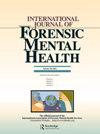Beyond Window Dressing: Does Moving to a New Building Really Shape the Perception of, and Actual Safety on Forensic Inpatient Programs?
IF 0.9
4区 医学
Q3 CRIMINOLOGY & PENOLOGY
International Journal of Forensic Mental Health
Pub Date : 2021-08-27
DOI:10.1080/14999013.2021.1973153
引用次数: 0
Abstract
Abstract Waypoint Centre for Mental Health Care expanded its facility in 2014 to include a new state-of-the-art forensic hospital building, called the Atrium. Prior to moving Waypoint’s forensic programs into the Atrium, the Therapeutic Climate Study (TCS) was launched in order to monitor changes in perceived and objective safety indicators among forensic staff and patients. The present study consisted of a 5-year cross-sectional sequential design, consisting of both survey and hospital administrative data. Across all years of data collection, inpatients ( = 256) reported higher perceived safety when compared to staff ( = 932). However, changes in perceived safety were not linear and only slightly improved for staff over time. Sociodemographic characteristics and perceived recovery measures predicted perceived safety for staff and inpatients, regardless of the move. Male staff reported higher perceived quality of patient-service provider relationships and lower perceived safety, whereas female staff reported higher perceived patient cohesion and higher perceived safety. Both staff and inpatients who perceived the hospital’s principles and practices as more recovery-oriented reported higher perceived safety. Inpatients who have been at the hospital longer reported lower perceived safety, regardless of the move. Hospital administrative data showed the number of incidents in a centralized emergency response system spiked right after the move but eventually tapered off, whereas the rates of violent incidents had increased and remained higher since moving to the new building. Results from this study suggest that staffs’ and inpatients’ sense of safety is determined by multiple factors, of which physical environment seems to play a less central role.超越橱窗装饰:搬到新建筑真的塑造了对法医住院项目的认知和实际安全吗?
Waypoint精神卫生保健中心于2014年扩建了其设施,包括一座新的最先进的法医医院大楼,名为中庭。在将Waypoint的法医项目转移到中庭之前,启动了治疗气候研究(TCS),以监测法医工作人员和患者感知和客观安全指标的变化。本研究包括一个5年的横断面序列设计,包括调查和医院管理数据。在所有年份的数据收集中,住院患者(=256)报告的安全感高于工作人员(=932)。然而,员工感知安全的变化并不是线性的,只是随着时间的推移略有改善。社会形态特征和感知恢复措施预测了工作人员和住院患者的感知安全,无论他们采取何种行动。男性工作人员报告称,患者服务提供者关系的感知质量较高,感知安全性较低,而女性工作人员则报告称,感知患者凝聚力较高,感知安全性较高。认为医院的原则和做法更注重康复的工作人员和住院患者都报告了更高的安全感。住院时间较长的患者报告称,无论采取何种行动,他们的安全感都较低。医院行政数据显示,集中应急系统中的事件数量在搬迁后立即激增,但最终逐渐减少,而暴力事件的发生率有所上升,自搬迁到新大楼以来一直居高不下。研究结果表明,工作人员和住院患者的安全感是由多种因素决定的,其中物理环境似乎不太重要。
本文章由计算机程序翻译,如有差异,请以英文原文为准。
求助全文
约1分钟内获得全文
求助全文

 求助内容:
求助内容: 应助结果提醒方式:
应助结果提醒方式:


